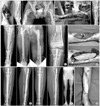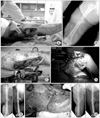Abstract
Purpose
To evaluate the delayed soft tissue coverage after previous negative wound therapy in treating wounds associated with open lower extremity fracture.
Materials and Methods
Between June 2007 and February 2011, delayed soft tissue coverage of open lower extremity fractures after previous use of a negative pressure vacuum device, were performed in 15 consecutive patients. Patients included 13 male and 2 female, and their mean age was 39.0 (7-65) years old. Information on the time from injury to definitive wound coverage, type of coverage, functional result, bone union, and complications such as infection were collected.
Results
The vacuum-assisted closure devices was applied for an average of 29.3 (9-50) days, and the mean time from injury to definitive wound was 36.1 (21-60) days. Skin graft coverage was performed in 5 cases, free flap in 8 cases, and local flap in 3 cases. The mean time to radiographic union was 5.2 (3-8) months and delayed union occurred in 2 cases.
Figures and Tables
 | Figure 1(A) A 31-year-old man sustained type III-B open tibia shaft fracture combined with both femur and head trauma. The hemodynamic state was unstable. (B) The vacuum-assisted closure system was applied to the open wound after debridement and temporary external fixation which was damaged by controlled surgery. (C) Unreamed tibial nail, femoral nails and plate were applied at two weeks after injury. (D) Anterolateral thigh flap was applied at 36 days after injury. (E) Autogenous iliac bone graft was applied to the bone defect at 2 months after injury to enhance bone healing. (F) The fractures were healed without complication. (G) Clinical photograph shows successful result after 4 months using the anterolateral thigh flap. |
 | Figure 2A patient with deep wound infection by methicillin-resistant Staphylococcus aureus. (A, B) Photograph and radiograph show extensive soft tissue defect and open comminuted fracture of femur shaft. (C) Severe deep wound infection developed after injury. (D) Repeated debridement and change of vacuum-assisted closure system for approximately 40 days. (E) After the infection subsided, undreamed femoral nail was applied. (F) Photograph shows successful result after 14 days using split-thickness skin graft. (G) The radiographs at 24 weeks after surgery show bridging callus around the fracture site. |
References
1. Yazar S, Lin CH, Wei FC. One-stage reconstruction of composite bone and soft-tissue defects in traumatic lower extremities. Plast Reconstr Surg. 2004. 114:1457–1466.

2. Godina M. Early microsurgical reconstruction of complex trauma of the extremities. Plast Reconstr Surg. 1986. 78:285–292.

3. Steiert AE, Gohritz A, Schreiber TC, Krettek C, Vogt PM. Delayed flap coverage of open extremity fractures after previous vacuum-assisted closure (VAC) therapy - worse or worth? J Plast Reconstr Aesthet Surg. 2009. 62:675–683.

4. Gustilo RB, Mendoza RM, Williams DN. Problems in the management of type III (severe) open fractures: a new classification of type III open fractures. J Trauma. 1984. 24:742–746.
5. Klemm KW, Börner M. Interlocking nailing of complex fractures of the femur and tibia. Clin Orthop Relat Res. 1986. 212:89–100.

6. Yaremchuk MJ, Brumback RJ, Manson PN, Burgess AR, Poka A, Weiland AJ. Acute and definitive management of traumatic osteocutaneous defects of the lower extremity. Plast Reconstr Surg. 1987. 80:1–14.

7. Ninković M, Schoeller T, Benedetto KP, Anderl H. Emergency free flap cover in complex injuries of the lower extremities. Scand J Plast Reconstr Surg Hand Surg. 1996. 30:37–47.
8. Hildebrand F, Giannoudis P, Kretteck C, Pape HC. Damage control: extremities. Injury. 2004. 35:678–689.

9. Roberts CS, Pape HC, Jones AL, Malkani AL, Rodriguez JL, Giannoudis PV. Damage control orthopaedics: evolving concepts in the treatment of patients who have sustained orthopaedic trauma. Instr Course Lect. 2005. 54:447–462.
10. Cierny G 3rd, Byrd HS, Jones RE. Primary versus delayed soft tissue coverage for severe open tibial fractures. A comparison of results. Clin Orthop Relat Res. 1983. 178:54–63.
11. DeFranzo AJ, Argenta LC, Marks MW, et al. The use of vacuum-assisted closure therapy for the treatment of lower-extremity wounds with exposed bone. Plast Reconstr Surg. 2001. 108:1184–1191.

12. Kanakaris NK, Thanasas C, Keramaris N, Kontakis G, Granick MS, Giannoudis PV. The efficacy of negative pressure wound therapy in the management of lower extremity trauma: review of clinical evidence. Injury. 2007. 38:Suppl 5. S9–S18.

13. Joseph E, Hamori CA, Bergman S, Roaf E, Swann NF, Anastasi GW. A prospective randomized trial of vacuum-assisted closure versus standard therapy of chronic nonhealing wounds. Wounds. 2000. 12:60–67.
14. Hertel R, Lambert SM, Müller S, Ballmer FT, Ganz R. On the timing of soft-tissue reconstruction for open fractures of the lower leg. Arch Orthop Trauma Surg. 1999. 119:7–12.

15. Kesemenli CC, Kapukaya A, Subaşi M, Arslan H, Necmioğlu S, Kayikçi C. Early prophylactic autogenous bone grafting in type III open tibial fractures. Acta Orthop Belg. 2004. 70:327–331.




 PDF
PDF ePub
ePub Citation
Citation Print
Print





 XML Download
XML Download